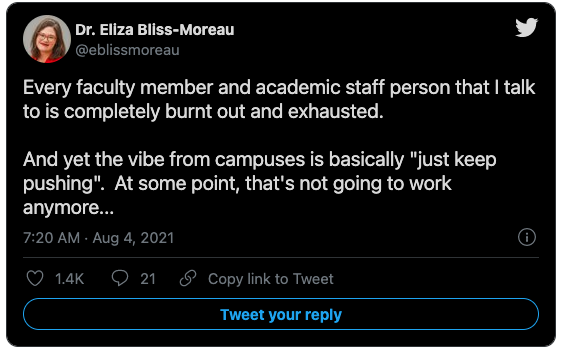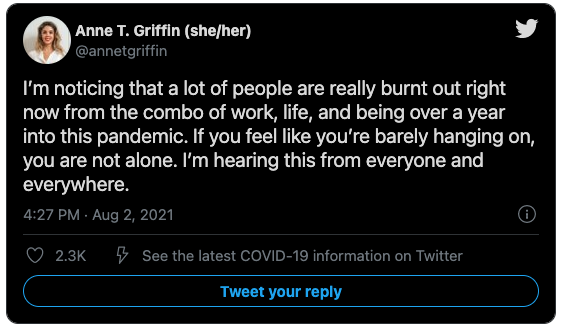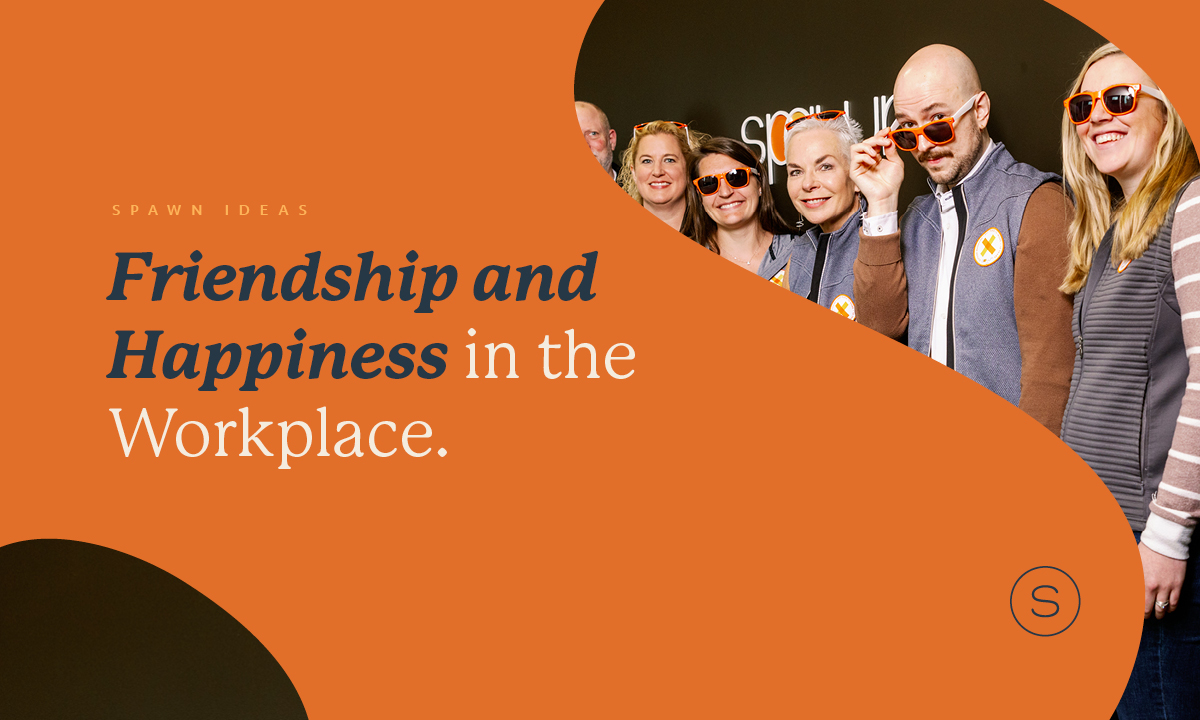Over the past year, many of us have experienced burnout more intensely and more often than ever before, given the instability associated with the pandemic. From transitioning to remote work, suddenly being on childcare watch 24/7, and the general financial stress, it’s no wonder many of us feel like our mental health is continually playing catch-up.

This widespread mental health challenge challenged organizational leaders to value mental health the same as – if not more so than – physical health, and invest in long-term employee burnout prevention. When 55% of Americans agree COVID-19 affects their mental health, it’s safe to assume many of your employees aren’t at their best.
But where to even begin prioritizing this mental health epidemic within your business? Let’s start by understanding what burnout even is.
What Is Burnout?
Though everyone experiences burnout differently, research shows that the most common symptoms include emotional exhaustion, feeling mentally worn out and drained, and depersonalization – the feeling of being detached from personal realities.
In the workplace, this could look like:
- Slipping job performance
- Lack of motivation
- Increased frustration, cynicism, and other negative emotions
- General decreased satisfaction
While for students, this could look like:
- Feeling exhausted no matter how much sleep you get
- Continuously missing class/incapability to meet important deadlines
- Increase in bad habits
- Inability to concentrate

How to Prevent Burnout
Workplace burnout isn’t a new problem we’re facing, however, its recent surge is enough for medical experts to describe it as frightening; increasing for workers by 52% and by 71% for students (up from 43% and 40% pre-pandemic, respectively).
The first step in preventing burnout is recognizing aspects prone to causing it and evaluating whether they are present in your working environment. The most common things that catalyze the downward spiral of burnout include:
- Demand overload
- Lack of control
- Insufficient reward
- Toxic environment
- Lack of fairness
- Value conflicts
A workplace evaluation can help decipher which areas need your initial attention. Does your staff feel overworked and underappreciated? Are they struggling to get along with colleagues or reach out to leadership? Do some generally disagree with the direction your company is taking?
The more aspects that contribute to burnout that are present in your environment, the more likely you are to confront it. And true prevention stems from taking actions that halt the effects of burnout before they even begin. So, if you or your coworkers find yourself experiencing more than one of these at any given time, it’s time to consider what you can and can’t change about your situation:
Block “meeting free” time
If you or your coworkers ever feel like they don’t have enough time in a day to get all the work done, the problem may not be an overload of work – it might just be too many needless meetings. Time for deep work without any other obligations keeps your team productive and encourages everybody to think twice about whether or not a meeting is necessary.
Encourage social interaction, but don’t force it
After-hour events can feel like a good idea while in planning but, come the day of, they may feel like a burden after a long day. Instead of forcing your team to connect off-the-clock, try to plan events during work hours and keep attendance optional.
Offer hybrid or permanent remote opportunities
Hybrid workers register higher levels of well-being translating to increased levels of morale and productivity. For meetings/training that require in-person attendance, consider live-streaming or recording sessions for those who learn best online, incorporating remote capabilities that allow employees to make this choice for themselves.
“Since we have been working from home, I have not felt any burnout. I am in my own space.” – Susanne
Foster communication
Using a company-wide survey or personality test to recognize how employees prefer to communicate helps strategic leadership develop powerhouse teams, happier employees, and generally better workforce efficiency. By making the results an exciting way for individuals to discover more about themselves, you can encourage your team to share their preferences while also gaining valuable insight on how to pair up everybody’s different personalities.
Switch “sick days” to “wellness days”
Despite how simple it sounds, changing a simple phrasing of your offered sick days allows opportunity for employees to rethink how they’re spending their time. With the increased popularity of online learning and remote opportunities, people are less likely to take time off. When you change “sick days” into “wellness days,” you encourage your employees to not only take the time off if they’re facing an emergency – but also if they just need time to recharge.

Incentivize physical activity
Regular exercise helps regulate stress levels in any working environment. You can easily incentivize physical wellness by offering extra credit for extracurricular activities, offering employees access to a local gym or a class, or engaging in company-wide fitness challenges.
“Walks during the work day and setting workout goals for myself is the first thing I do to prevent burnout.” – Ashley
Give recognition where recognition is due
Give praise and encourage milestone celebrations to ensure individuals know their efforts are appreciated and something to be proud of. Received a B when the class average for the exam was a C-? Celebrate it! Conquer a client’s large request? Celebrate it! A little celebration goes a long way in fighting burnout.
Don’t ask underrepresented groups to solve inclusivity problems
Being a minority in the workplace inherently contributes to increased levels of burnout. While many are happy to see organizations prioritize inclusivity, it’s not your employees’ job to solve diversity problems. Instead of barraging them with questions about race, gender, or sexual orientation, create company-wide surveys to gather information and educate large groups as a whole.
Support work-from-home days during the absence of reliable childcare
Women, especially those with children, are experiencing burnout at higher rates than others. You can help alleviate pressures experienced by both moms and dads by encouraging work-from-home days when childcare is needed.
Resources





